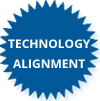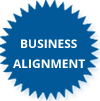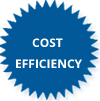The company has on its consultancy panel experienced IT professionals who have previously worked with Infosys, IBM, IBM-Netsol, HCL, Dell, Ericsson, McAfee,Toshiba, TCS, etc. The combined experience of these professionals, who are Erudite IT Professionals Pvt. Ltd.’s consultants in developing the course and projects execution, is over 200 person years. The overall team has multinational experience of executing medium and large scale IT infrastructure projects (both implementation and maintenance).
How EITP delivers business value
An optimized IT infrastructure can create business value for enterprises by leveraging existing technology assets and emerging trends while creating efficient internal processes. With a proven consulting-led approach, EITP enables enterprises to leverage emerging technologies while optimizing their IT infrastructure.
Our Process of Delivering Excellence
A well designed IT Service Delivery Model is critical to achieving success in IT Management and operations

Key Components of a Robust IT Service Delivery Model
Governance

- Executive Oversight
- Explicit alignment of bussiness and IT Strategy
- Project Prioritization
- Budgeting and funding
- Enforcement and adherence
- Proactive issue and risk management
Organization

- Organizational design
- Roles and responsibilities
- Centralized vs. distributed activities
- In-house vs. outsourcing
- Staff competency models
- Integration accross technology plateforms
Operational Processes

- Portfolio management
- Enterprise architecture
- Infrastructure optimization
- Vendor management
- Project/Program mangement
- Application development/ maintenance
Performance Management

- Performance Management framework
- Cost and performance tranceparency
- Common metrices/targets definition
- Alignment of service levels and bussiness needs
- Corrective action
As we’ve assigned our clients with their IT Service delivery models, We have gained a number of insights that are important to consider

Observation
Lesson Learned

Observation
Lesson Learned

Observation
Lesson Learned

Observation
Lesson Learned
Our experience has enabled us to drive operational improvements that can lead to significant cost savings in a number of areas.
Typical Operational improvement
- Increased focus on application reuse,application lifecycles, and the ability to sunset technologies when appropriate.
- Enhanced ability to identify “synergy targets” and consolidate during M&A activity.

Typical “Hard” Benefits
- 15%-20% reduction in hardware and software costs(considers equipment,licensing,and support).
- More integrationwith the business and its goals and objectives.
- A better understanding of how to apply disparate technologies to specific business challenges and opportunities.

- 25%-30% reduction in rework.
- 25%-30% improvement in customer SLA compliance(internal and external).
- Greater overall cost visibility,control,and management.
- Enhanced ability to identify savings opportunities,address them,and make them “stick”.

- An average total cost of ownership(TCO) reduction of 10% and 20%,and in some cases,much more.
- Ability to adjust quickly to ever changing business priorities and needs(e.g,unforeseen business events in strategy,M&A).
- Reduction in the proliferation of”IT”.

- 15%-25% reduction in cycle time.
- 25%-50% improvement in developement request response times.

